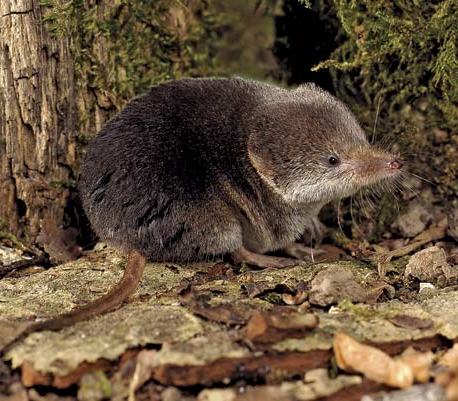
Common shrew, or Eurasian shrew(Sorex araneus)
Phylum —chordata
Class — mammalia
Order — eulipotyphla
Family —soricidae
Genus— sorex
Appearance
It is 55 to 82 millimeters (2.2 to 3.2 in) long and weighs 5 to 12 grams (0.2 to 0.4 oz), and has velvety dark brown fur with a pale underside. Juvenile shrews have lighter fur until their first moult. The Common shrew has small eyes, a pointed, mobile snout and red-tipped teeth.
Habitat
The Common shrew is the most abundant species of its family, occurring throughout Eastern Europe, Scandinavia and Great Britain.
Behavior
The Common shrew is a solitary creature. This animal will fiercely defend its home range against outsiders. Although generally nocturnal, the Common shrew can be active during both day and night. It usually has alternating periods of rest and activity during the 24-hour day. Each period of activity lasts for 1-2 hours on average, after which the shrew will rest, generally in its nest. However, this animal can take a nap wherever it finds suitable. When looking for food on the ground, it explores and sniffs the area with its snout and whiskers while giving out a characteristic high-pitched sound. Being a very small mammal, it cannot store enough winter fat and hence, doesn't undergo hibernation. The Common shrew is known to create system of runways in the vegetation. This animal may either dig a burrow or simply use one, abandoned by another small mammal.
Diet
The Common shrews are carnivores, their diet is generally composed of earthworms, spiders, slugs, insect larvae, beetles and other invertebrates, supplemented with small vertebrates and occasional carrion.
Reproduction
The Common shrews are polyandrous animals, which means that one female mates with multiple males. They usually mate from April to August. Females may yield up to 4 litters per year, although they generally produce 1-2. About 6-7 babies are born after 19-21 days of gestation. As a result of their reproductive system, young from one litter may have 2-3 different fathers. Newborn shrews start venturing from the nest at 16 days old. During this period, they are known to follow their mother, forming a "caravan". This often happens, when their nest is disturbed. When moving around in a caravan, one of the babies holds its mother's tail while each baby grabs the tail of the one in front of it. Weaning occurs after 26-30 days old. The age of reproductive maturity is 9-10 months old.
It has a lifespan of approximately 14 months.
In captivity
Keep shrews in a well-ventilated terrariums or cages with a small distance between the rods.
The main disadvantage of their keeping is their insatiable appetite. Feed them every 3 hours in the afternoon, while leaving plenty of food at night and do not forget to feed in the morning. Such forgetfulness can lead to the sudden death of the animal from starvation.
In addition, shrews are very aggressive towards each other. Therefore, they have to be kept either in separate or well-fenced cages.
It is necessary to feed shrews with mealworms, other insects, frogs, mice, fish, minced meat, liver, and kidneys. They like crackers, some fresh or dried berries and fruits
 Russian
Russian
 English
English























